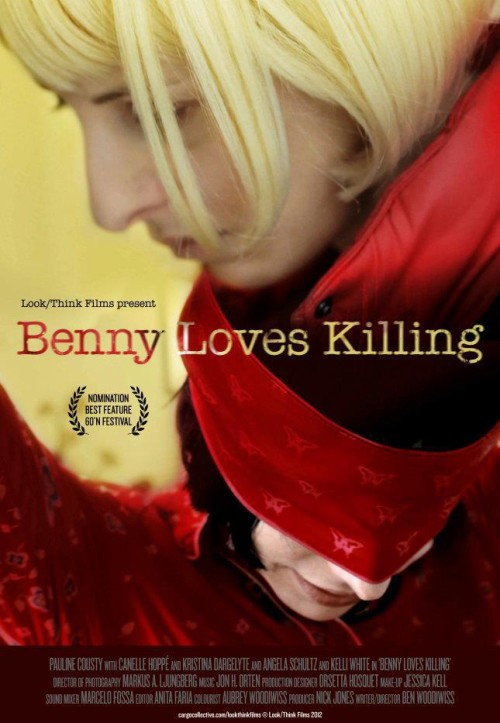Written by Max Thornton.
“Why horror?”
“Because I think it’s the most flexible genre…the most malleable genre. You are able to experiment and discuss the text without interfering with the object itself.”
So say Benny and her professor in the first set of dialogue in Ben Woodiwiss’s quietly excellent indie feature Benny Loves Killing, setting the scene for the experimentation and discussion to come. Although it has won at least one award for “Best Horror Film,” Benny Loves Killing isn’t really a horror film as such. Or rather it is, to use Benny’s own words, “a meta-horror film. A horror film about horror film. More importantly, a horror film about cinema.” I think one could argue that, whether or not it’s explicitly meta (and there’s plenty of superb horror that is, from Peeping Tom to Cabin in the Woods), horror is always, to some extent, about cinema. As far back as The Cabinet of Dr. Caligari, horror films have been self-consciously Jungian, awash with dreamscapes and archetypes, exploiting the visual and sonic immediacy of the medium to inhabit and unsettle the viewer’s psyche.

But Benny Loves Killing is a meta-meta-horror film, a film about somebody making a film about film. Benny is a French film student in the UK making a horror film for a class, but we don’t actually see very much of her film. There are plenty of movies about making a movie, to the point where it’s arguably a little passé, and Benny Loves Killing is careful not to ever be heavy-handed or obnoxious in its extra layer, addressing it obliquely.
“Oblique” is a good word for most of this film’s approach – by which I absolutely don’t mean obscure or pretentious, but subtle and thought-provoking. This is one of those films where the more you think about it the better it gets. It’s not quite psychological horror, but the narrative does largely follow Benny’s tenuous state: bumming from one friend to another, refusing to take a shower, stealing from those around her, doing way too many drugs, arguing with her mother, having some fantastically creepy nightmares. The direction of the film is gorgeously stylish and evocative, with uses of chiaroscuro and splashes of red that probably deserve scene-by-scene analysis.
There are a few conversations where the characters discuss the film they are making, but the meta-commentary never gets inelegant. In one scene, Benny and her colleague Alex argue about the workings of point-of-view shots: “You sympathize with who you’re looking at, not with the eyes you’re looking through,” Benny insists, invoking the classic killer’s-viewpoint horror shot. If up to this point in the film you had overlooked the subtleties of how point of view is used, from here on you would surely notice how often the camera stays on Benny, with her interlocutor barely in frame – especially when these are men, especially men with power (the professor, the board that controls Benny’s funding, a creeper at a party). The effect is a claustrophobically intense focus on Benny, emphasizing her overwhelming and precarious mental state, but there’s also a complex and nuanced commentary here about gender in cinema.

The most explicit discussion of gender and cinema occurs in the scene where Benny and Alex are screen-testing an actress who admits that their names had led her to expect two men, and then expresses her wariness of the widespread misogyny in the horror genre. Like any filmmaker who cannot step into the text of the film without thereby becoming a part of it, Benny allows the actress to speak without defending herself. There is no great rush to defend the feminist credentials of horror in general or of Benny’s film in particular, simply the opening of a conversation: is the camera necessarily a male gaze, even when wielded by a woman? Is a camera-on-camera the male gaze doubled or reversed or negated? How do the layers of agency and power operate in a male filmmaker’s film about a female filmmaker’s film?
Benny is surely to some degree an avatar for writer/director Ben Woodiwiss, and the different wigs she dons can be seen as a literalization of the different “hats” an independent filmmaker perhaps inevitable wears, as well as the multiplicity of her relationship to the camera eye. While Benny is not unsympathetic, she is certainly no wish-fulfillment self-insert, either in her personal or her professional life. Her cinematic ambitions are grandiose, but perhaps all talk: she constantly says she’s trying to do something innovative, to make a different kind of film, but nothing we see about the film-within-the-film suggests that it’s anything other than a conventional horror film, with its buckets of fake blood and negotiations with actresses about topless scenes. To what extent, the film seems to be asking, can the filmmaker have mastery over her film and its tropes? Or do film and tropes have mastery over the filmmaker?

The question is deepened by the mother/child imagery throughout the film. Benny’s fraught relationship with her mother doesn’t precisely parallel her relationship with her film, but it echoes it: despite, or perhaps at the root of, their conflicts, Benny comes from her mother, is shaped by her, inherits her flaws and characteristics. A creative work is its maker’s baby, and the mother gives the baby life but also, in the very life itself, life’s horizon of death, natality and mortality intertwined. The unleashing of the creative work into the world marks the author’s death, but for the auteur, it is also the death of her baby through her loss of control over it, birthed and killed at once in the cutting of the umbilical cord.
If Ben(ny) indeed loves killing, (s)he invites us, with a small smile and a gaze directly into the camera, to confront the lens and its powers of life and death: who, exactly, is being killed? And who, exactly, is doing the killing?
___________________________________________________
Max Thornton blogs at Gay Christian Geek, tumbles as trans substantial, and tweets at @RainicornMax.
